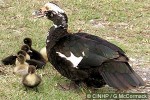Cook Islands Biodiversity Database
Species Page
Cairina moschata
Mokorā Kainga (AT)Muscovy Duck
Multimedia & Additional Resources
| Type | Description | Download |
| Female and ducklings | 80KB |
General Information
Cook Islands Distribution
| Southern Group: Present Makatea: | ||||||||
RR |
MG |
AT |
MK |
MT |
AK |
PL |
TK |
MN |
++ |
+ |
+ |
+ |
X |
+ |
- |
- |
- |
| Northern Group: Present? | |||||
TN |
MH |
RK |
PK |
NS |
SW |
X |
- |
- |
+OI |
- |
- |
Scientific Taxonomy
Cairina moschata (Linnaeus)
TAXONOMY: ANIMALIA; CHORDATA; GNATHOSTOMATA (Jawed Vertebrates); TETRAPODA; AVES; NEORNITHES; Anseriformes; ANATIDAE
More Information
SIGNIFICANCE NOTES -. Comment: NBSAP - Takitumu (3 of 3 domestic), NBSAP - Mauke (1= of 3 domestic animals), NBSAP - Mitiaro (2 of 4 domestic animals)
POSITIVE SIGNIFICANCE: Food
GENERAL NOTE: Known as Muscovia or Muscovy Duck since at least 1650. Muscovia / Muscovy being the area of Moscow and, by extension, Russia in general. Said to be an erroneous name, with Barbary Duck, for the Musk Duck of tropical America, so named for its musky smell.
The wild Muscovy Duck is a perching duck spending much time in trees in dense forests near ponds and streams. They feed mainly on aquatic plants. They are dark brown with a bright green-purple gloss, and white patches on the wings. The male is distinuished by elongate feathers forming a small crest on the head and by having small red wattles.
Vouchers & References
Vouchers:
None Recorded.
References:
None recorded.
Data Update History (information):
zTX, zB02, zM02, zD02
Web Resources
Citation Information
McCormack, Gerald (2007) Cook Islands Biodiversity Database, Version 2007.2. Cook Islands Natural Heritage Trust, Rarotonga. Online at http://cookislands.bishopmuseum.org. ![]()
Please refer to our use policy.

